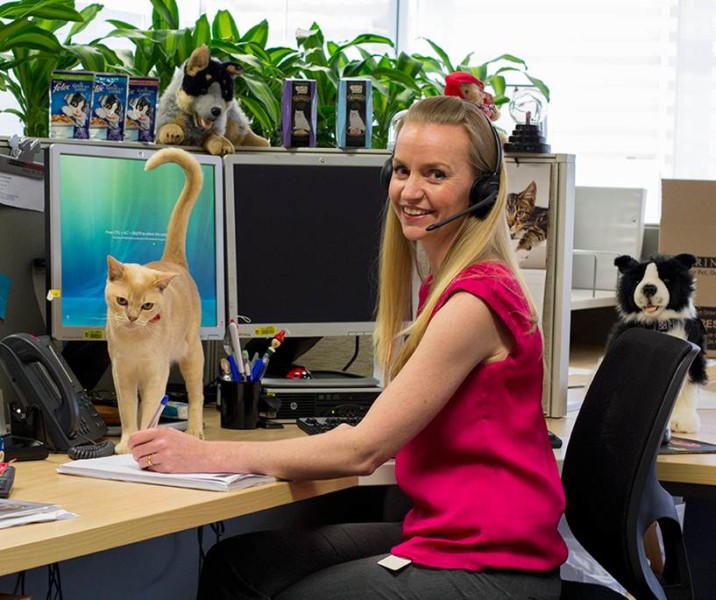We all know that pets make great friends. But can they also be great co-workers? This past Friday was Bring Your Pet to Work Day, and businesses across Australia opened their office doors to furry friends everywhere.
In the spirit of animal companionship, here are some ways pets might benefit your office and how you can go about implementing a ‘pets at work’ (PAW) program. It could very well make your days at the office a little less ruff.

First, the benefits.
- Pets are the ultimate people pleasers: Studies have shown that animals in workplaces act as social catalysts and encourage collaboration among employees. Workers tend to rate their teammates higher in terms of trust, team cohesion and intimacy in offices where pets are present.
- Increased work-life balance: Bringing pets to work means employees aren’t worrying about their pets sitting at home all day. Often employees are willing to stay later when working on important projects because they aren’t rushing off to feed the cat or let the dog out.
- Lowered stress: It’s no secret that scratching a dog’s belly is a great stress reliever. A study conducted in 2012 showed that employees who bring pets to work produced lower levels of the stress hormone cortisol and higher levels of oxytocin. Having pets around can also lower blood pressure and increase opportunities for exercise during the day.
- Increased creativity and productivity: Sometimes all it takes to get the creative juices flowing is a quick walk around the office. Having pets around makes it easy for employees to take brief mental breaks and return to work refreshed and ready to problem solve.
- The morale factor: Wouldn’t it be nice if all disputes could be solved with a game of fetch? Some workplace issues require more attention, but if the internet has taught us anything it’s that animals have excellent comedic timing to relieve tension. Pets can immediately perk up a workspace and contribute to a comfortable, open and flexible work environment.
If all of this sounds appealing, here are some steps you can take to make your office a pet-friendly one:

1. Get everyone involved
Before you go any further with your plan, you should first gauge the interest of employees. Make sure everyone has the chance to address any concerns about having animals in the workplace, especially concerning animal allergies. Then, work together to create guidelines for bringing pets to work. Will it be an everyday kind of thing? A roster? Just one day a year? Tailor the policy to fit with the wants and needs of your employees.
2. Get building approval
Approach management and ask them to discuss the idea of bringing pets to work. Be prepared with a checklist and provide examples of other pet friendly organisations (Google, Purina and Australian Vet Association all have successful, longtime pet programs). It’s also a good idea to think of some potential risks ahead of time so you can easily address them. Some offices even have committees to monitor pets at work, enforce any rules and handle discipline issues.

3. Make sure pets have documentation
You wouldn’t let random people just show up to the office one day, right? The same should apply to any office animals. Before an employee brings his or her pet to work, it’s a good idea to have them fill out forms to keep a record of what animal they are bringing, its breed/gender/age, whether it has had all of its shots and whether it has any potential obedience issues. Any employee bringing a pet to work should also sign a liability waiver to remove risk and liability from the company. Once the pet is approved, give the employee an animal ID card or certificate to display somewhere so it’s easy to spot who has approval.
4. Make sure the office is pet-ready
Designate areas of the office where animals are off limits to ensure workers can get away from office pets if they want or need to. Keeping areas that involve food – such as kitchens, canteens or break rooms – pet free is a good place to start, as well as bathrooms and a couple meeting rooms.
Stress to employees the importance of good pet etiquette as well. Make sure that employees bring any appropriate materials for their pets, such as food bowls, bedding, toys, gates or litter boxes. Workers need to be responsible for their own animals, so clearly outline what is expected of them should your office implement a PAW policy.
5. Make sure pets are ready for the office
As much as offices are the ‘home away from home’ for many people, it probably won’t be the same for their pet. If possible, ask employees to try and introduce their pet to the workplace ahead of time when so many people aren’t there, such as after hours, during a half day or on a weekend. If multiple people are bringing pets, it’s a good idea to do introductions outside the office and walk animals in together. Ask employees to groom pets beforehand as well – it’ll help keep the office clean and minimise shedding.


What a JOKE ! Wouldn’t it be a hoot if a dog took a dislike to a cat at work. Your dog just ate my cat ! I am sure than would be great for team morale. Just imagine the litigation that could follow between the two staff and of course if would be the employer’s fault for allowing this to occur. At times its hard enough to control the behaviour of people at work, let alone control alone the behaviour of their pets at work. Under the WHS legislation an employer has a Duty Of Care to provide a… Read more »
I have a pet friendly workplace and it has numerous benefits. It is important that the pet is suitable for the environment, i.e. house-trainied, calm, well behaved and well groomed. Staff who do not have pets due to living arrangements love having interactions with them, there has also been an improvement in the fitness of staff who ‘borrow’ a pet when they do the coffee run or go out to get lunch, or just take a dog for a walk. The office has become a more friendly, more relaxed place with improved atmosphere. Also pet owners who bring their pets… Read more »
Good grief! Not another Committee………..
Now where did my pet death adder go – it was in my office a few minutes ago!…………..
Your dog ate my cat…………….
Your cat ate my mouse…………………
Don’t forget to make time for the pets to have OH&S and Corporate Inductions! And of course a code of conduct for employee pets!
Not to mention the employee who goes off on a stress claim because she doesn’t like animals, thinks they’re filthy and can’t bring her baby to work, so why can everybody bring their cats and dogs! You can’t be serious – this is a productivity booster? If this happened in our office NOBODY would do any work for the whole day.
Disappointing the shrill comments above. I’ve seen pets-in-workplace policies work really well and without incident. You folks sound as if you need an office pet to reduce your stress!